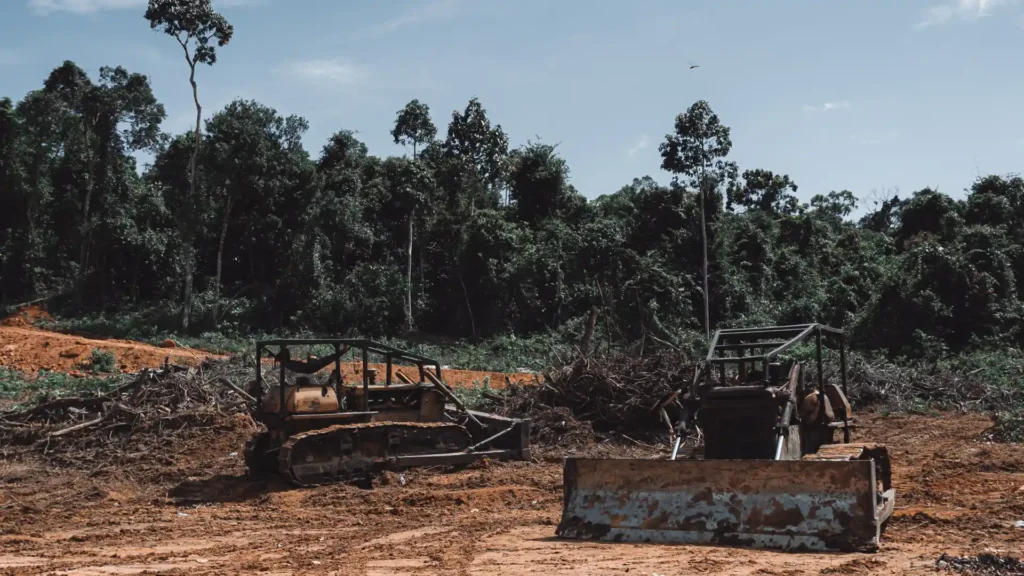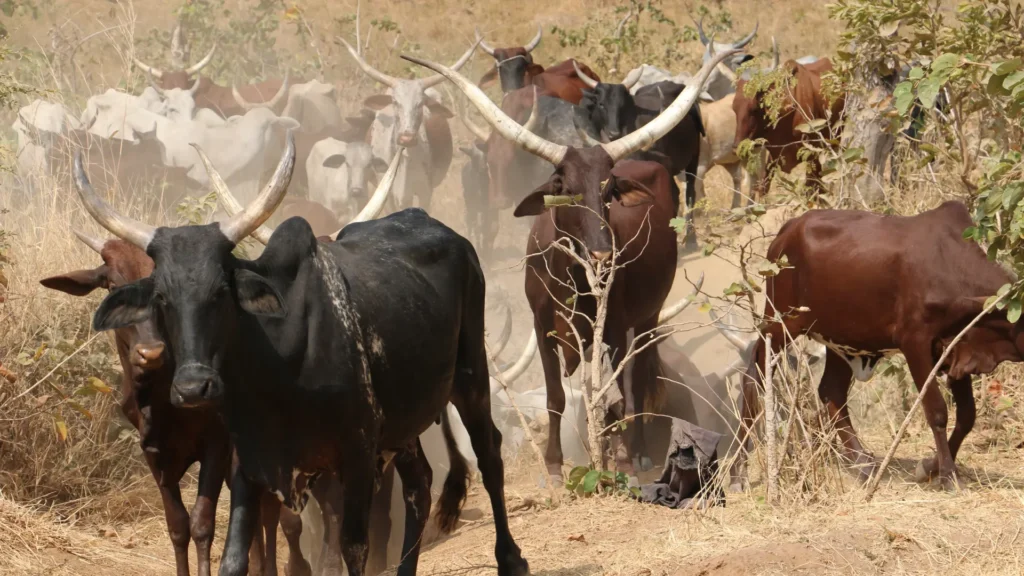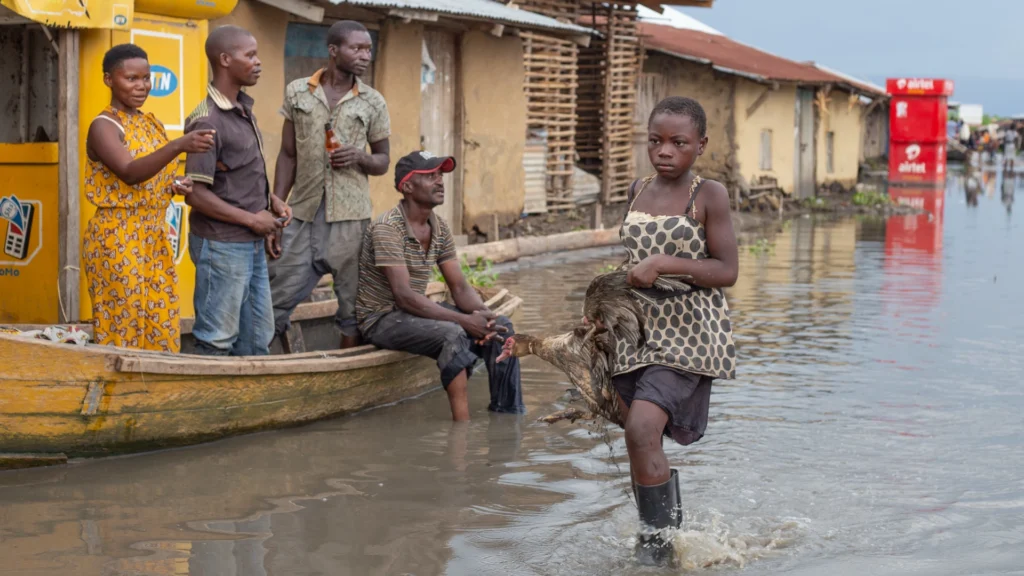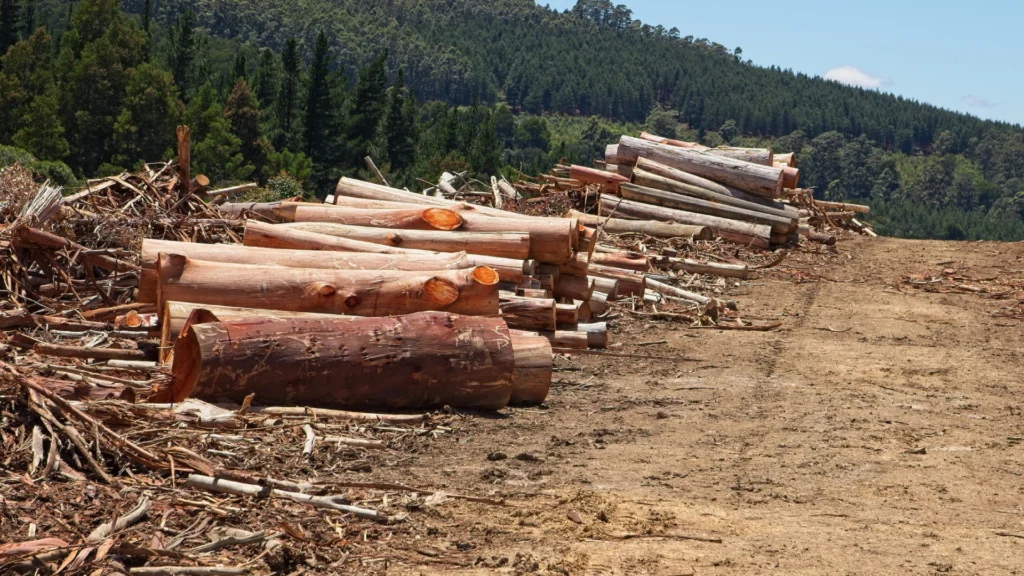Introduction
Ten thousand years ago, forests covered more than half of the Earth’s habitable land – land where humans could live. Forests now make up less than a third (31 per cent) and that amount is shrinking1https://www.fao.org/3/CB9360EN/online/src/html/executive-summary.html due to ‘deforestation’ – the chopping down of forests.
Between 1990 and 2020, 420 million hectares (1.6 million square miles) of forest were lost due to deforestation.2https://www.fao.org/documents/card/en/c/ca9825en The United Nations (UN) says that 10 million hectares of forest were lost each year between 2015 and 2020.1https://www.fao.org/3/CB9360EN/online/src/html/executive-summary.html One hectare is about the size of a European football field.
Deforestation in Uganda

While deforestation might be slowing down in most parts of the world, this is not the case in Africa. Africa is chopping down over 15,000 square miles (nearly 4 million hectares) of forests every year, at almost double the speed of the rest of the world.3https://www.researchgate.net/publication/372789229_Deforestation_and_its_Impacts_on_the_Population_in_Uganda
In Uganda, the last 10 years have seen an alarming rise in deforestation. In 2001, the country destroyed 115 square miles of forest, but by 2020 Uganda was clearing 284 square miles of forest in a single year.4https://www.fes.de/en/shaping-a-just-world/article-in-shaping-a-just-world/ugandas-silence-at-cop26-over-growing-deforestation According to the UN, “an average of 122 000 hectares [471 square miles] of forest area has been lost every year from 1990 to 2015, amounting to a loss of around 63 per cent of the country forest cover in this period.”5https://www.fao.org/3/cb7080en/cb7080en.pdf If Uganda doesn’t take urgent action, it will lose all its forest in the next 25 years.6https://www.theguardian.com/global-development/2020/jun/29/cooking-up-a-solution-to-ugandas-deforestation-crisis-with-mud-stoves
At COP26, a meeting of over 100 world leaders to fight climate change, it was agreed to end and reverse deforestation by 2030. However, Uganda’s government refused to agree to this.4https://www.fes.de/en/shaping-a-just-world/article-in-shaping-a-just-world/ugandas-silence-at-cop26-over-growing-deforestation
Farming – the biggest cause

The UN says that the growth of farming is the single biggest driver of deforestation, causing almost 90 per cent of global forest loss. It says 52 per cent of these losses are from growing crops (including crops to feed farmed animals) and 38 per cent is from animal farming, such as grazing beef cattle.1https://www.fao.org/3/CB9360EN/online/src/html/executive-summary.html However, in many parts of the world, such as South America and Oceania, livestock grazing is the biggest driver of deforestation.1https://www.fao.org/3/CB9360EN/online/src/html/executive-summary.html
As the demand for meat and dairy products in Uganda grows, more forests will be lost to deforestation. This is terrible news for Uganda’s already-suffering environment.
Find out more
According to the UN, “large-scale commercial agriculture and subsistence agriculture account for over 70 per cent of deforestation in tropical and subtropical countries” and Uganda is an “emblematic” example of this.5https://www.fao.org/3/cb7080en/cb7080en.pdf The UN estimates that by 2050, the demand for meat and milk products in Uganda will more than double and “the production of all types of meat and that of milk will increase by 164 and 41 per cent, respectively.”7https://www.fao.org/3/ca7009en/CA7009EN.pdf
Illegal deforestation and land grabbing

A report called Illicit Harvest, Complicit Goods showed that many farmed products exported worldwide from Latin America, Southeast Asia and Africa are linked to illegal deforestation.8https://www.forest-trends.org/publications/illicit-harvest-complicit-goods/ It found that between 2013 and 2019, 69 per cent of tropical deforestation for commercial farming was illegal. In Uganda, for example, it is common for cattle ranchers to illegally grab and deforest land from Queen Elizabeth National Park and use it for farming beef cattle.9https://conbio.onlinelibrary.wiley.com/doi/abs/10.1111/cobi.12538?campaign=woletoc
“We should all be shocked that illegal clearing for commercial agriculture is the largest driver of deforestation – and that it’s getting bigger. If we don’t urgently stop this unlawful deforestation, we don’t have a chance to beat the three crises facing humanity: climate change, biodiversity loss and emerging pandemics” said one of the authors of the report.
Why forests matter
Often referred to as the ‘lungs’ of the Earth, trees store carbon inside them and release oxygen into the atmosphere.
Carbon dioxide (CO2) in the atmosphere warms the planet, causing global heating but trees take this CO2 out of the atmosphere, storing the carbon and releasing the oxygen for us to breathe. They store 80 per cent of the total above-ground carbon in their trunks, branches and leaves and 40 per cent of the below-ground carbon in their roots.10Li Q, Jia Z, Feng L et al. 2018. Dynamics of biomass and carbon sequestration across a chronosequence of Caragana intermedia plantations on alpine sandy land. Scientific Reports. 8 (1) 12432
Trees also keep soil stable, preventing landslides, and reduce flooding. What’s more, by pulling cold water up through their roots from deep underground and releasing it from their leaves, tropical forests help cool down the atmosphere. One study estimates that tropical forests may cool Earth by a whole 1°C11Lawrence D, Coe M, Walker W et al., 2022. The unseen effects of deforestation: Biophysical effects on climate. Frontiers in Forests and Global Change. 5, 756,115 – that might sound small, but a rise of just a couple of degrees would cause a global catastrophe! So, preserving forests is crucial for combatting global heating. Without trees, it’s unlikely that we will survive.
When forests are removed, there are fewer trees to take carbon from the atmosphere and if trees are burned or left to rot, more carbon is released. This disastrous double-whammy is why deforestation causes around 11 per cent of all global greenhouse gas emissions.12IPCC. 2014. IPCC. 2014. Climate Change 2014: Synthesis report. Contribution of Working Groups I, II and III to the Fifth Assessment Report of the Intergovernmental Panel on Climate Change [Core Writing Team, RK Pachauri and LA Meyer (eds.)]. IPCC, Geneva, Switzerland, 151 pp. In the Amazon, burning trees is the main source of carbon emissions13van Marle MJE, Field RD, Werf GR et al. 2017. Fire and deforestation dynamics in Amazonia (1973-2014). Global Biogeochemical Cycles. 31 (1) 24-38 and, likewise, in Uganda it is farming and savannah-burning leading the carbon emissions.14https://ozone.unep.org/Meeting_Documents/research-mgrs/7orm/7orm-Uganda.pdf
Local impacts of deforestation

We need forests for the health of the planet, but deforestation has direct impacts on local people too. Deforestation causes unusual dry seasons, with prolonged periods of drought and unpredictable heavy rainfall. In fact, according to the Centre for Research on the Epidemiology of Disasters, Uganda was considered the fourth most affected country by extreme weather in 2019.4https://www.fes.de/en/shaping-a-just-world/article-in-shaping-a-just-world/ugandas-silence-at-cop26-over-growing-deforestation This extreme weather causes harvests to fail and leads to flash flooding.3https://www.researchgate.net/publication/372789229_Deforestation_and_its_Impacts_on_the_Population_in_Uganda
In the last few years, Uganda has suffered from increasingly deadly floods which have destroyed homes, schools and farms. In Kasese, in western Uganda, extreme tree clearing in highland areas, such as the Rwenzori mountains, has left the soil loose and unable to retain water.6https://www.theguardian.com/global-development/2020/jun/29/cooking-up-a-solution-to-ugandas-deforestation-crisis-with-mud-stoves As a result, every year floods tear through the valley, leaving a deadly path of a destruction in their wake.15https://www.unicef.org/uganda/helping-kasese-rise-above-floods
In the town of Nyowa, which borders Murchison Falls National Park, human-wildlife conflict is becoming more common because of deforestation. Whereas the animals used to roam freely in the park, deforestation has caused them to roam further afield looking for food and healthier habitats. They end up entering people’s gardens, destroying crops, homes, and sometimes injuring and occasionally even killing locals.4https://www.fes.de/en/shaping-a-just-world/article-in-shaping-a-just-world/ugandas-silence-at-cop26-over-growing-deforestation This often results in retaliation from the locals who shoot and poison the desperate animals.
Deforestation and zoonoses

Forests are home to a quarter of the world’s biodiversity – the variety of all life on Earth. They provide a home for 80 per cent of amphibian species, 75 per cent of bird species and 68 per cent of mammal species.1https://www.fao.org/3/CB9360EN/online/src/html/executive-summary.html More than 28,000 different plant species are used in medicines and many of them come from forests. We risk losing valuable future medicines if deforestation continues. Yet, forests also pose health risks if we don’t leave them alone.
Most new infectious diseases, including covid and mpox (previously known as monkeypox), are zoonotic – they come from animals and can be caught by humans. Zoonotic diseases from forests include malaria, Chagas disease, African trypanosomiasis (sleeping sickness), leishmaniasis, Lyme disease, HIV and Ebola.16https://www.fao.org/3/ca8642en/ca8642en.pdf There will be more if we don’t stop deforestation.
Go vegan, save the planet
When forests are cleared for crops, most of them are grown to feed farmed animals. Most of the soya grown in Latin America, for example, is used for animal feed to fuel the global supply of animal-based fast foods. And, in Uganda, precious forest and savannah is being cleared to graze cattle for beef and dairy.
Changing what we eat could have a huge impact on reducing deforestation and combating climate change. Researchers say that if the world went vegan, we could grow enough food for everyone in 2050 without another single tree being cut down.17Erb KH, Lauk C, Kastner T et al. 2016. Exploring the biophysical option space for feeding the world without deforestation. Nature Communications. 7, 11382 That means zero deforestation! If the land used previously for grazing animals was allowed to return to forest, the carbon captured and stored in trees could be large enough to cancel out up to 300 years of food-related greenhouse gas emissions.18Bryngelsson D, Wirsenius S, Hedenus F et al. 2016. How can the EU climate targets be met? A combined analysis of technological and demand-side changes in food and agriculture. Food Policy. 59, 152-164
Scientists agree that if we are seriously going to limit global heating to 1.5°C – the threshold beyond which Earth’s climate will become dangerously disrupted – deforestation must end. Not only would this combat climate change, but it would also create other local and global benefits – such as biodiversity conservation and the protection of soils and water.1https://www.fao.org/3/CB9360EN/online/src/html/executive-summary.html In other words, the entire future of humanity depends on it!
References
References
- 1
- 2
- 3
- 4
- 5
- 6
- 7
- 8
- 9
- 10Li Q, Jia Z, Feng L et al. 2018. Dynamics of biomass and carbon sequestration across a chronosequence of Caragana intermedia plantations on alpine sandy land. Scientific Reports. 8 (1) 12432
- 11Lawrence D, Coe M, Walker W et al., 2022. The unseen effects of deforestation: Biophysical effects on climate. Frontiers in Forests and Global Change. 5, 756,115
- 12IPCC. 2014. IPCC. 2014. Climate Change 2014: Synthesis report. Contribution of Working Groups I, II and III to the Fifth Assessment Report of the Intergovernmental Panel on Climate Change [Core Writing Team, RK Pachauri and LA Meyer (eds.)]. IPCC, Geneva, Switzerland, 151 pp.
- 13van Marle MJE, Field RD, Werf GR et al. 2017. Fire and deforestation dynamics in Amazonia (1973-2014). Global Biogeochemical Cycles. 31 (1) 24-38
- 14
- 15
- 16
- 17Erb KH, Lauk C, Kastner T et al. 2016. Exploring the biophysical option space for feeding the world without deforestation. Nature Communications. 7, 11382
- 18Bryngelsson D, Wirsenius S, Hedenus F et al. 2016. How can the EU climate targets be met? A combined analysis of technological and demand-side changes in food and agriculture. Food Policy. 59, 152-164

